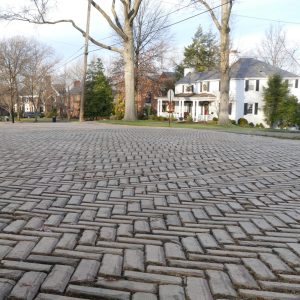Shanksville then and now

September 15, 2002, serves as no landmark date to anyone but me. One year and four days following what was arguably the biggest tragedy in U.S. history, my husband and I embarked on a pilgrimage to the Flight 93 memorial in Shanksville.
2,977 people unexpectedly lost their lives on September 11, 2001. Of those, 40 perished when a plane crashed in a rural field near Somerset, just a short drive away from our cozy Mt. Lebanon neighborhood.
The scene from Shanksville in 2002 could best be described as organic and raw. Even the damp, grey day set a perfect tone for the somber visit. Upon stepping out of the car in a flat, muddy parking lot, the first and only sound that immediately flooded the ears was the flapping of an endless sea of American flags.
The makeshift memorial, just after the first anniversary, drew modest crowds compared to what we’d see now on any random given day. The experience of walking those grounds could only be considered visceral. It was sobering, stark and patriotic. Though a small crowd marveled at tokens left in remembrance as they placed their own trinkets down, no one uttered a sound.

It was like an unspoken agreement amongst us strangers. We all experienced and shared emotions in awe without exchanging a word.
To prepare for our trip, my husband painted an American flag on a piece of unused canvas we found shoved away in a closet. At the time, the crash site just had some temporary fencing for visitors to secure their mementos. With a freshly painted flag in hand, my husband, Jason, stood on his tippy-toes and pinned his creation to the fencing, among thousands of other items, mostly colored in a variation of red, white and blue.
We quietly shuffled around to study the tiny homemade angel statues lining the ground, as well as everything else mourning strangers left behind. After we paid our respects, we returned to the car and drove home with a permanent memory and somber feeling etched into our core.
Each year, when the anniversary approaches, we conjure up our past story and recount it to our daughter. Now that she has reached her teenage years, she has a keen interest on the history of this event. This year, she requested that we all return to Shanksville.
So 20 years and three days after Jason’s and my visit, we returned to the Flight 93 National Memorial. The makeshift fence erected on a vast expanse of vacant land has since been replaced by acres of meticulously executed memorial elements.
Although the memorial bears no resemblance to the small and intimate scene we encountered two decades prior, it creates its own intimacy for 400,000 annual visitors. The attention to detail from the site planners’ is evident throughout.
The numbers 93 and 40 dominate every inch of the space. Flight 93 (with 40 victims onboard) met their fate that day and there’s no escaping the gravity of those two numbers.

We stopped at the Tower of Voices, the memorial’s gateway and learned that the majestic wind chime towers 93 feet in the air and features 40 metal chimes, which elicit a subtle melody of remembrance.
Touring through all the places you can visit (the Visitors Center, the Wall of Names and the Tower of Voices), the near silence amongst hundreds of visitors struck me the same as the day I visited two decades ago. It wasn’t difficult to spot someone silently shedding a tear as they relived that devastating day.
We found flowers, memorabilia and coins thoughtfully placed along the 40 names etched in the stone wall that led down to the site of impact. We left 40 cents ourselves. As we traveled down that walkway, we heard a park ambassador explain that in 2018, the plane wreckage was placed in containers and buried onsite. They discovered five more human bones amongst the remaining wreckage and those bones were added to the ashes of the victims.
One year later, the urn, with the ashes and those five bones, were also buried onsite—40 feet deep. This was done strictly for the grieving loved ones to experience. No media was present.

After reaching the end of the path, we peered through a gate created with hemlock wood, and observed a boulder that marked the south end of the crash crater. This gate, which sits as close as anyone can get to the crash site, is composed of multiple beams that the designers scored with 40 slashes into the wood. Only direct family members are permitted to venture beyond the gate onto the sacred site.

For the last part of our visit, we sought out the spot where the initial makeshift fencing stood 20 years prior—the original home of Jason’s hand-painted flag. The only way to reach the now nearly vacant space is to walk on a modest gravel path named the Trail of Remembrance.
The three of us traveled the winding, half-mile path alone. It was that intimate experience I craved from so many years ago. Grasshoppers led the way in front of us, alongside a field of wild yellows and purples, until we reached the end.
A simple sign marked the end of our walk. We stood on the hillside and took in the warm September breezes, listened to a peaceful serenade from crickets and paid our respects. We then walked back to the car for our two-hour drive home.
Each of these experiences will stick with me in vastly different, yet similar ways. The past can’t be what it was, and the memorial proves that life evolves. But sometimes we all still need to stop to take in the enormity of history, before we begin traveling along again.
This is an experience my child will take with her, and likely when she raises her kids, they’ll journey to this site and she’ll share the story of her visit 20 years prior. Through her, and all our children, we will never forget—and this history will remain relevant.






